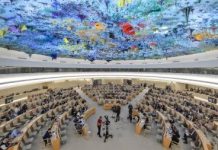While the exact mechanism of its transmission to humans remains unconfirmed by scientists, the virus responsible for the COVID-19 pandemic is genetically linked to a cluster of coronaviruses discovered in horseshoe bats inhabiting Southeast Asia, Reuters reported.
“If you’re a mammalian virus, you couldn’t find a better host, because of the ability of bats to spread you far and wide,” said Hume Field, an Australian veterinary epidemiologist who has co-authored more than 300 studies on bats and viruses.
The transmission of viruses from bats to humans can occur either through an intermediate host, such as a pig, chimpanzee, or civet, or via direct contact between humans and bat urine, faeces, blood, or saliva. These instances of transmission are referred to as “spillover.”
Certain factors, including tree loss, precipitation, temperature, and land cover, can create an environment that is more favourable for spillover events.
Understanding that – and knowing where it is most likely to happen – is key to reducing pandemic risk, scientists say.
The global depletion of resources is leading to the widespread destruction of regions that are abundant in bats, which serve as carriers for tens of thousands of viruses.
A data analysis conducted by Reuters identifies specific areas where the conditions are favourable for the transmission of diseases from bats to humans. We’ve labelled these areas “jump zones.”
For centuries, viruses carried by bats posed minimal danger to human populations. The presence of undisturbed wildlife habitats acted as a natural buffer, safeguarding against pathogen transmission.
However, human activities and encroachments have transformed these once-protected zones into high-risk areas spanning over 9 million square kilometres across 113 countries, as discovered by Reuters. Alarmingly, over one-fifth of the global population now resides in these vulnerable regions.
Conditions are ripe for a bat-borne virus to spill over, possibly sparking another pandemic.
These areas, which Reuters dubbed “jump zones,” cover 6% of Earth’s land mass. They are mostly tropical locales rich in bats and undergoing rapid urbanization. Nearly 1.8 billion people, one-fifth of humanity, lived in these jump zones in 2020.
Analyses such as this that identify areas where spillover risk is high can give companies and governments an opportunity to stay ahead of the problem.
“Identifying hotspots and creating models to predict what might happen would actually help governments a lot,” said Etien Koua, epidemic intelligence manager for Africa at the World Health Organization, or WHO.
Stopping an outbreak before it happens, most health experts say, is far less costly, in lives and money, than relying on the kind of readiness and response capabilities the world scrambled to put together when COVID-19 hit.
“When an outbreak happens, everybody is mobilized,” Koua said. “Once it goes away, we tend to come back to normal life again and think: ‘Well, it’s probably okay, we can live the same way.’”
Reuters travelled and spoke with over 100 researchers studying and working in bat habitats worldwide. From Brazil to Australia, the forests of West Africa to the limestone caverns of Southeast Asia, scientists say humanity can’t afford to keep ravaging wildlife habitats.
There is no quick or easy fix to avoid all spillovers, they say, but their insights and suggestions could one day help keep future pandemics at bay.
In order to address the potential dangers associated with particular projects, scientists and public health experts are urging governments globally to establish a formal procedure for assessing health risks before developmental activities disrupt delicate habitats.
While many countries mandate environmental impact assessments prior to initiating infrastructure projects or making alterations to an area, there are few regulations in place that specifically require evaluations of how deforestation or habitat modifications contribute to the spread of diseases.
The push is for comprehensive assessments that take into account these considerations to better safeguard public health.
“Health impact assessments would change how companies approach projects,” said Chadia Wannous, a coordinator at the World Organization for Animal Health, an intergovernmental group that combats animal disease and is part of ongoing negotiations with other global agencies on regulations to reduce spillover threats. “It would contribute to driving the risk down over time.”
But just as in the case of climate negotiations, where nations are baulking at major cuts in fossil-fuel consumption, working out changes in the way countries allow development in wildlife areas is an enormous challenge.
The pace of discussions involving scientists, public health experts, national governments, and international agencies is characterised by deliberation and gradual progress. Achieving consensus and fostering collaboration across scientific disciplines and policymakers are essential elements of these ongoing discussions.












